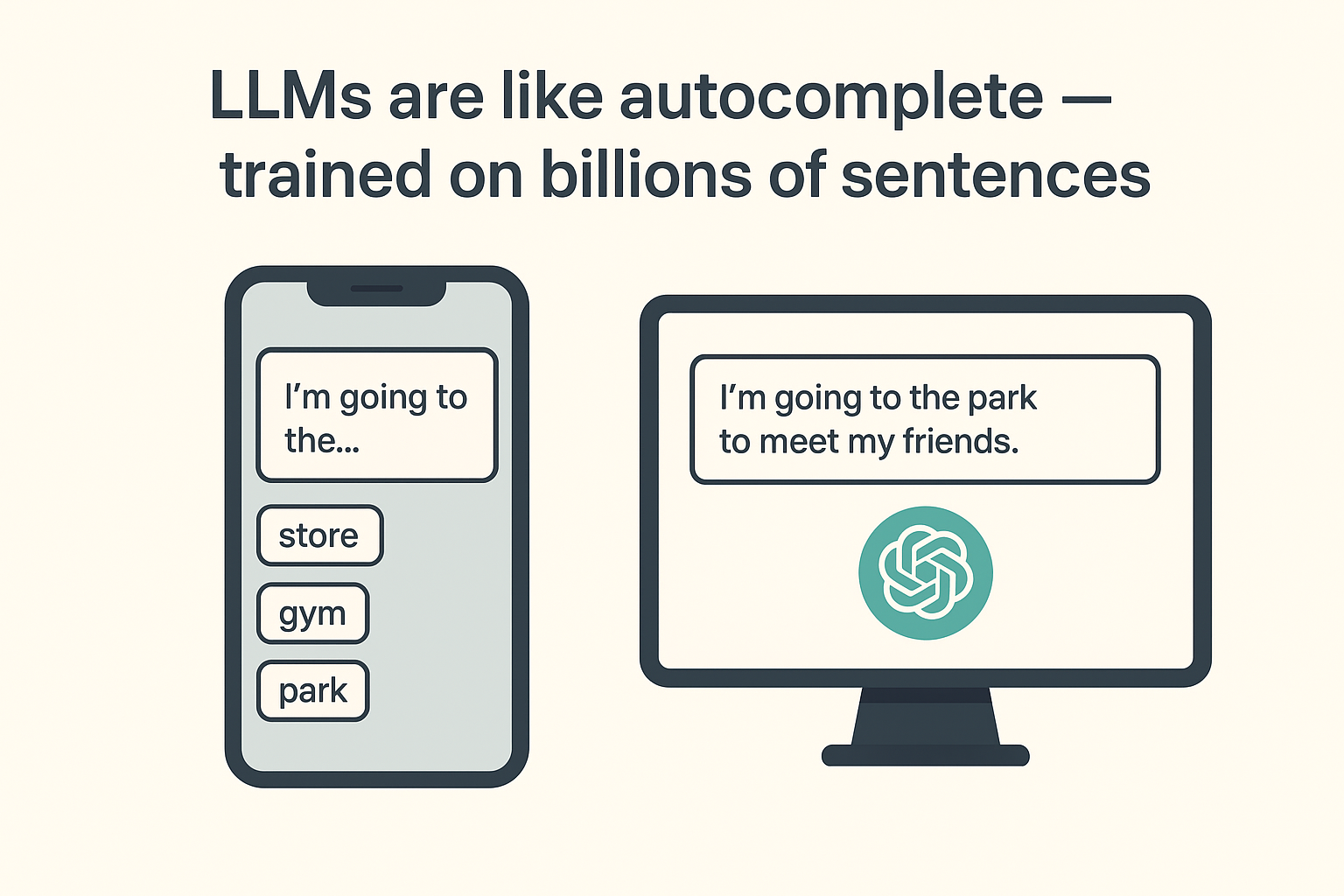If you’ve ever used ChatGPT, a coding assistant, or even your phone’s autocomplete, you’ve interacted with something called a Large Language Model (LLM). These systems can write essays, translate bodies of work into various languages, generate code for complex applications, or even help draft business emails. But how exactly do they work?
At first glance, the magic behind LLMs can feel like something out of a sci-fi movie. Yet beneath the surface, they’re built on principles that can be understood with the right explanation. In this article, we'll take a peak under the hood of one of the most transformative technologies of the 21st century.
What is a Large Language Model?
At its core, an LLM is a computer program trained to predict the next word in a sequence. That’s it. No really, that's it.

Imagine your phone's auto-complete feature. You start typing a sentence like "I am going to the..." and it suggests "gym" or "supermarket", both of which makes sense in the context of the sentence. Now imagine this auto-complete has read billions of books, articles and human conversations, with the abiity to generate full essays, stories, or code snippets. That's an LLM.
At it's core is a Neural Network, more specifically a Transformer. This network contains billions (sometimes Trillions) of parameters, trained on massive text datasets to model probability distributions over sequences of tokens. Now it's important to state that LLMs don't "think" like humans do. At least, not yet anyways (winks in AGI). It's simply recognizing patterns and continuing them in a way that looks like human reasoning.
So... How do they learn?
LLMs are trained on massive datasets: books, articles, codebases, images and videos, and a lot more. Pretty much the entire internet's worth of text. It's like reading every book in the biggest library on earth. You tend to develop a strong sense of how sentences are structured. You might not memorise everything, but you get pretty good at guessing what words tend to follow others.
During its training, the model adjusts its parameters to minimize prediction error when guessing the next token. Over billions of training steps, it refines its internal representation of language.
Cool... So what's the brain behind this learning?
To understand how LLMs process text, we need to first discuss their underlying architecture. Take the following sentence as an example:
The cat chased the dog, but it ran...
To process the above text and figure out what the next possible word should be, the LLM first breaks this into special parts known as tokens. A token can be a word, subword or individual characters in a sentence. This process of breaking a sentence into tokens is known as Tokenization.
Next, the tokens are turned into Embeddings. These are numerical vector representation of a token that captures the semantic meaning and relationships of a word, subword or character. Words that have similar meanings have embeddings that are close to each other in a multi-dimensional space.
Next, the embeddings pass through multiple Transformer layers. The Transformer architecure is the foundation of most popular LLMs. This architecture allows the LLM to process and understand all the words in the above sentence at the same time rather than one after the other. The process by which it achieves this is through a method called self-attention. In simple terms, self-attention is the mechanism that allows the LLM figure out how each word relates to every other word in the text.
The final layer of the processing outputs a probability distribution over the next possible token. Based on the weights of the distribution, it selects one of the outputs that it thinks is most likely to complete the sentence in a way that makes sense. With the above example, the outputs could be "outside, away, inside, downstairs". The model randomly picks one of these outputs and presents the final sentence:
The cat chased the dog, but it ran outside
Putting it all together
So far, we've seen what LLMs are, how they learn and how they process text. At their core they are sophisticated pattern recognition machines trained to predict the next word in a sequence, powered by neural networks with billions of parameters.
What makes them extraordinary is the scale. With enough data and compute, these models capture subtle patterns of language that allow them to write, reason, and even create in ways that feel natural to us. They don’t truly “understand” the way humans do, but their ability to recognize and reproduce patterns has made them one of the most transformative technologies of the 21st century.
What does the future hold?
Looking ahead, LLMs will continue to evolve. We are beginning to see smaller, specialized models for various industries like Medicine and Law. With this progress will also come important conversations about ethics, bias, and how to use these systems responsibly.
The big picture? LLMs aren’t magic. In our quest to move humanity forward with technological advancements, LLMs can help us reach the next level of productivity that expands what we can build, how we can communicate, and even how we imagine the future of human–AI collaboration.